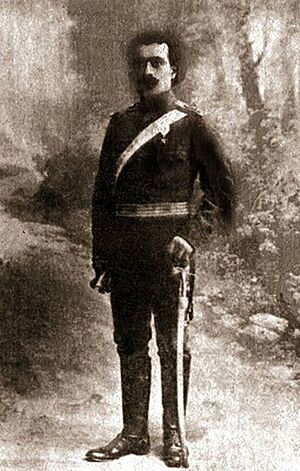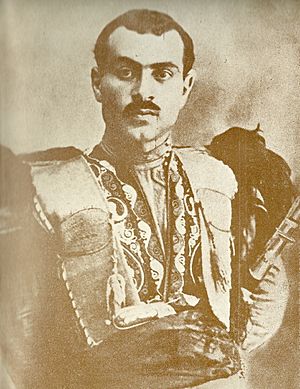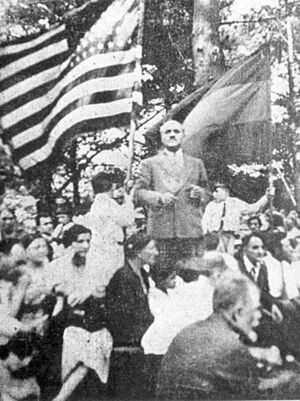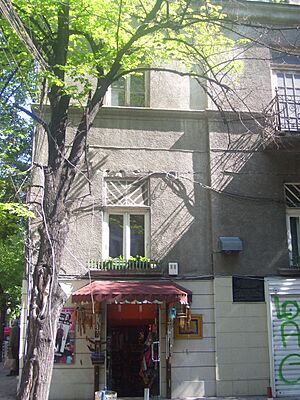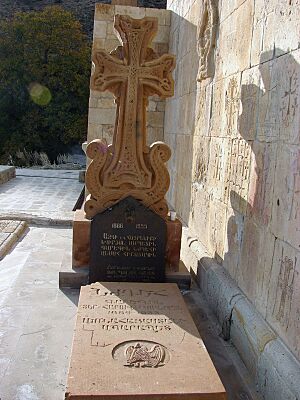Garegin Nzhdeh facts for kids
Quick facts for kids
Garegin Ter-Harutyunyan
|
|
|---|---|
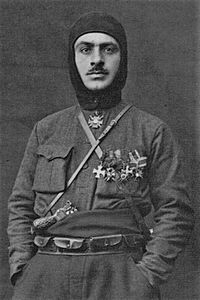 |
|
| Native name |
Գարեգին Առաքել Եղիշեի Տեր-Հարությունյան
|
| Birth name | Garegin Ter-Harutyunyan |
| Other name(s) | Garegin Nzhdeh |
| Born | 1 January 1886 Kznut, Erivan Governorate, Russian Empire |
| Died | 21 December 1955 (aged 69) Vladimir Central Prison, Vladimir, Soviet Union |
| Buried |
Spitakavor Monastery
|
| Allegiance | |
| Rank | Sparapet |
| Battles/wars | First Balkan War Second Balkan War Armenian national liberation movement World War I Caucasus Campaign Armenian–Azerbaijani War |
| Awards | Order of Courage of the Kingdom of Bulgaria Order of Saint Vladimir 3rd class of the Russian Empire Order of Saint Anna 4th class of the Russian Empire Order of Saint George 3rd class of the Russian Empire Order of Saint George 2nd class of the Russian Empire |
| Spouse(s) | Epimé Sukiassian (m. ?–1955) Gohar Dadayan |
| Children | Vrezh Lilia Dadayan |
Garegin Ter-Harutyunyan, also known by his fighter name Garegin Nzhdeh (Armenian: Գարեգին Նժդեհ, 1 January 1886 – 21 December 1955), was an important Armenian leader. He was a statesman, military commander, and political thinker. As a member of the Armenian Revolutionary Federation, he fought for Armenia's freedom. He was a key leader during the Balkan Wars and World War I. He also played a big role in the Democratic Republic of Armenia (1918–1921). Many Armenians see him as a national hero.
In 1921, Nzhdeh helped create the Republic of Mountainous Armenia. This was a state that opposed the Bolsheviks (communists). His actions helped keep the Syunik region as part of Soviet Armenia. During World War II, he worked with Germany. He hoped this would protect Soviet Armenia if Germany won the war and if Turkey tried to invade. In 1944, Nzhdeh was arrested in Bulgaria. He was sentenced to 25 years in prison in the Soviet Union. He died in Vladimir Central Prison in 1955.
Contents
Early Life and School
Garegin Ter-Harutyunyan was born on January 1, 1886. His village was Kznut (now Güznüt) in the Nakhichevan region. He was the youngest of four children. His father, a village priest, died when Garegin was young. Nzhdeh went to a Russian school in Nakhichevan city. Later, he studied at a high school in Tbilisi.
After that, he moved to Saint Petersburg to study law at the university. But after two years, he left to join the Armenian national movement. This movement was fighting against the Ottoman Empire. In 1906, Nzhdeh went to Bulgaria. He finished his military training there and became a lieutenant in the Bulgarian army in 1907.
Balkan Wars
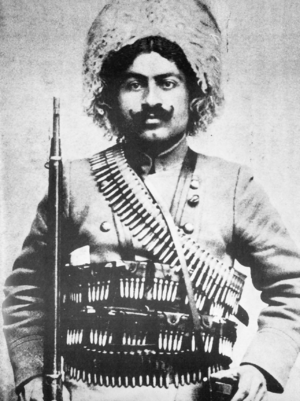
In 1907, Nzhdeh returned to the South Caucasus. In 1908, he joined the Armenian Revolutionary Federation. He also took part in the Persian Constitutional Revolution with other Armenian fighters.
In 1909, Russian authorities arrested Nzhdeh. He spent three years in prison. In 1912, he joined the Bulgarian army with General Andranik Ozanian. They fought against the Ottoman Empire in the Balkan Wars. Nzhdeh was wounded during the Second Balkan War. The Bulgarian army gave him the Cross of Bravery award. This was for the courage of the Armenian fighters.
World War I
Before World War I, Nzhdeh received a pardon from Russia in 1914. He returned to the Caucasus to help form Armenian volunteer groups. These groups fought with the Russian army against the Ottoman Empire. In 1915, he became a deputy commander. He served under Drastamat Kanayan (Dro), leading the 2nd Volunteer Battalion. Later, in 1916, he led a special Armenian-Yezidi military unit. After the Russian Revolution, the Russian army left. Nzhdeh's unit fought battles near Ani in 1918. This helped Armenian forces retreat safely to Gyumri.
Battle of Karakilisa and the First Republic of Armenia
After fighting Ottoman forces in Alexandropol, Nzhdeh's Armenian fighters built defenses in Karakilisa (now Vanadzor). Nzhdeh was key in getting troops ready for the Battle of Karakilisa in May 1918. He inspired local people and refugees to fight. He gave a powerful speech, calling Armenians to a sacred battle. Nzhdeh was wounded in the fight. After four days of intense battle, both sides had many losses. The Armenians ran out of ammunition and had to pull back. The Ottoman army took Karakilisa but could not go deeper into Armenia.
In April 1920, Nzhdeh led his troops to Mountainous Karabakh. This was after the massacre of Armenians in Shushi. Other Armenian forces also marched to Karabakh. Their actions helped stop the killings of Armenians there. However, the Soviet army then took over Azerbaijan. The Armenian forces were greatly outnumbered. On May 24, 1920, Nzhdeh and other leaders agreed to leave Karabakh. They handed power to local Armenian Bolsheviks.
While in southern Armenia, Nzhdeh's forces removed Turkic-speaking people from some villages. He was wounded again near Goris. In August 1920, Nzhdeh refused orders to leave Kapan. This was part of an agreement with Soviet Russia to let the Red Army enter Zangezur (Syunik), Karabakh, and Nakhichevan. In January 1920, Nzhdeh's fighters attacked Muslim villages near Goris. This led Azerbaijan to send forces back to Zangezur.
Republic of Mountainous Armenia
The Soviet army invaded the First Republic of Armenia on November 29, 1920. After Armenia became Soviet on December 2, 1920, the Soviets promised to rebuild the army and protect Armenians. They also said they would not punish non-communists. But this last promise was broken.
The Soviet government wanted Mountainous Karabakh and Zangezur to be part of Soviet Azerbaijan. Nzhdeh strongly disagreed with this. He was against the Bolsheviks. He gathered his forces in Syunik and led a movement against them. In December 1920, he declared Syunik a self-governing region. In January 1921, Drastamat Kanayan advised Nzhdeh to let Syunik become Soviet. This would gain Bolshevik support for Armenian lands. But Nzhdeh stayed in Syunik. He continued to fight against the Red Army and Soviet Azerbaijan to keep the region independent.
On February 18, 1921, the Dashnaks led an anti-Soviet uprising in Yerevan. They took control for about 42 days. But the larger Red Army defeated them in April 1921. The rebellion leaders, along with 8,000 refugees and 4,000 soldiers, then went to Syunik.
On April 26, 1921, a meeting in Tatev declared the independence of Daralagiaz, Zangezur, and Mountainous Karabakh. They named it the Republic of Mountainous Armenia. Nzhdeh was its prime minister and defense minister, with the title sparapet (supreme commander). On June 1, the republic was renamed the Republic of Armenia. Simon Vratsian became prime minister, but Nzhdeh remained sparapet.
From April to July 1921, the Red Army launched big attacks on Syunik. After many fierce battles, the Republic of Mountainous Armenia surrendered in July 1921. This happened after Soviet Russia promised to keep the mountainous region as part of Soviet Armenia. After the fighting, Nzhdeh, his soldiers, and many Armenian thinkers crossed into Iran.
Later Activities
After leaving Syunik, Nzhdeh stayed in Tabriz, Iran, for four months. His relationship with the ARF leaders got worse. He was removed from the party in September 1921. Soon after, he moved to Sofia, Bulgaria. There, he married Yevphime, an Armenian woman, and they had a son named Vrezh. Later, the ARF reviewed his case and let him back into the party.
Nzhdeh traveled to Bulgaria, Romania, and the United States. He visited Armenian communities in places like Plovdiv, Bucharest, and Boston. He inspired them and started an Armenian youth movement called Tseghakron in Boston in 1933. This group later became the Armenian Youth Federation, which still exists today.
In 1934, Nzhdeh returned to Sofia. In 1937, he went to Cairo, where the ARF leaders tried to fix their differences with him. But they failed. After returning to Sofia, Nzhdeh resigned from the ARF. The party also removed him for his "dividing activities." In 1937, Nzhdeh started publishing an Armenian newspaper called Razmik in Plovdiv. He also founded the Taron Nationalist Movement and published its newspaper, Taroni Artsiv. Even after leaving the ARF, his articles were still published in their newspapers.
World War II, Arrest, and Death
During World War II, Nzhdeh suggested supporting the Axis powers (like Germany) if they attacked Turkey. In 1942, Nzhdeh was asked to join the Armenian National Council in Berlin. This group was created by Nazi Germany to get Armenian prisoners of war to join their army. That year, the Nazis formed the Armenian Legion, made mostly of captured Soviet Armenian soldiers. It was led by Drastamat Kanayan. Nzhdeh helped write for Azat Hayastan ("Free Armenia"), a newspaper that supported Germany and was against the Soviet Union.
In 1943, Armenian battalions were sent to Crimea. Nzhdeh went with Dro to Nazi-occupied Crimea and then to the North Caucasus. He returned to Bulgaria in 1944. On September 9, 1944, Nzhdeh wrote a letter to Stalin. He offered his help if the Soviet Union attacked Turkey. Soviet leaders were discussing invading Turkey at that time. Soviet military commanders told Nzhdeh that his idea was interesting. They said he needed to go to Moscow to discuss it more. He was taken to Bucharest and then to Moscow. There, he was arrested and held in the Lubyanka prison. Another story says Nzhdeh hid after the Communist takeover in Bulgaria in 1944. He then turned himself in and was taken to Moscow.
After his arrest, Nzhdeh's wife and son were sent away from Sofia to Pavlikeni.
In November 1946, Nzhdeh was sent to Yerevan, Armenia, for trial. On April 24, 1948, he was charged with "counterrevolutionary" activities from 1920–1921. He was sentenced to 25 years in prison, starting from 1944.
Life in Prison and Death
Between 1948 and 1952, Nzhdeh was held in Vladimir Central Prison. Then, until mid-1953, he was in a secret prison in Yerevan. According to a fellow prisoner, Nzhdeh's move to Yerevan was to help him talk with Dashnak and Soviet leaders. They wanted to create a way for both sides to work together against Turkey. Nzhdeh and his fellow prisoner wrote a letter to the ARF leader Simon Vratsian. It asked him to cooperate with the Soviets against Turkey. But the Soviet leaders in Moscow refused to send the letter.
While in prison, Nzhdeh was taken from Vladimir to Armenia several times. He was shown how Soviet power had helped Armenia.
Nzhdeh died in prison. Soviet authorities sent a telegram to his brother, Levon. Levon went to Vladimir for the burial. He received Nzhdeh's watch and clothes. But he was not allowed to take Nzhdeh's personal writings. These were published in Yerevan years later. The authorities also did not allow Nzhdeh's body to be moved to Armenia. Levon Ter-Harutyunyan buried Nzhdeh in Vladimir. He wrote on the tombstone in Russian: "Ter-Harutyunyan Garegin Eghishevich (1886–1955)."
Funerals and Memorials

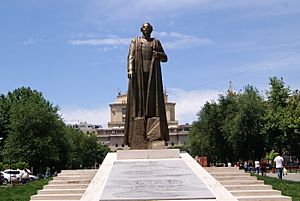
On August 31, 1983, Nzhdeh's remains were secretly moved from Vladimir to Soviet Armenia. This was done by Pavel Ananyan, Nzhdeh's granddaughter's husband, and others. On October 7, 1983, Nzhdeh's right hand was placed on Mount Khustup. Nzhdeh had wished to be buried there to see Kapan and other areas.
The rest of Nzhdeh's body was kept hidden until May 9, 1987. It was then secretly moved to Vayots Dzor Province. It was buried in the churchyard of the 14th-century Spitakavor Surb Astvatsatsin Church. Nzhdeh's gravestone was put up on June 17, 1989. This day became an annual pilgrimage day to the monastery.
Years after his death, on March 30, 1992, Nzhdeh was cleared of charges by the new Republic of Armenia.
On April 26, 2005, during the 84th anniversary of the Republic of Mountainous Armenia, parts of Nzhdeh's body were moved again. They were taken from Spitakavor Church to Khustup. So, Nzhdeh was reburied for the third time. He finally rests on the slopes of Mount Khustup near his memorial in Kapan.
In March 2010, Nzhdeh was chosen as the "National pride and the most outstanding figure" of Armenians. This was by voters of a TV project called "We are Armenians."
In Yerevan, a public square and a metro station are named after Nzhdeh. Nzhdeh, Armenia, a village in the Syunik Province, is also named after him.
Awards
| Country | Award | Year | ||
|---|---|---|---|---|
| Order of Bravery | For Bravery | 16 November 1912 | ||
| Order of St. Vladimir | 3rd class | 1915, 1918 | ||
| Order of St. Anna | 4th class | 1915 | ||
| Cross of St. George | 3rd class | 1916 | ||
| Cross of St. George | 2nd class | 1916 | ||
Written Works
Garegin Nzhdeh wrote many articles and books. He wrote about his experiences in the wars and his ideas for Armenia. Some of his works include "Pages from my diary" and "The Movement of the Spirit of the Nation." He also wrote "Covenant of Tseghakronism," which was about a youth movement he started. His writings are important for understanding his thoughts and the history of Armenia.
Images for kids
See also
 In Spanish: Garegin Njdeh para niños
In Spanish: Garegin Njdeh para niños


